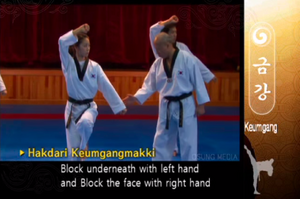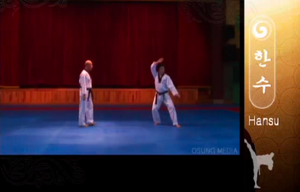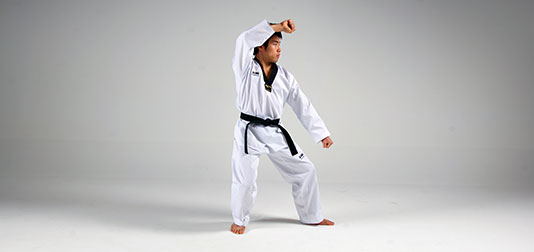
Diamond Block in the form Keumgang.

Knifehand Diamond Block in the form Hansoo
A Diamond Block (also called Keumgang Block or keumgang makgi) is a combination of:
- a High Block, with
- either a Low Block (geumgang naeryeo yeom makgi) or an Inner-Forearm Outward Block (geumgang bakkat makgi)
When the High Block is combined with an Outward Block, the block is also called a Twin Forearm Block (especially in ITF-style taekwondo).
As with many blocks, either of these variations can also be done with Knifehands (sonnal keumgang naeryeo yeom makgi and sonnal keumgang bakkat makgi, respectively).
Appearance[]
- When done with a Low Block, the Diamond Block appears for example in the form Keumgang.
- When done with an Outward Block, the Diamond Block appears for example in the form Palgwae Sa Jang.
- When done with knifehands, the Diamond Block appears for example in the form Hansoo.
When used in Keumgang, the fist of the Low Block should align with the raised foot of the Crane Stance. You should be looking in the direction of the Low Block.
Chambering and Performance[]

Tae Kwon Do - Diamond Block
How to perform the Low Block version of the Diamond Block
For the version that uses a Low Block, the chambering is as follows. For this explanation, assume the right arm will be doing the High Block.
- Chamber the left fist in front of the left shoulder, palm facing inward. In other words, your left elbow is almost completely bent.
- Chamber the right fist in front of the left waist, palm facing inward, as if it were in a Hinge position.
- The right fist begins to move first. It moves upward in a path toward the left shoulder. The left arm has not yet begun to move. At this point, the right fist is traveling up the length of the left forearm.
- When the right fist is about halfway up the left forearm, the left fist begins to travel straight downward. In other words, the left elbow needs to move backward as if you're hitting somebody behind you with your left elbow. When the left fist is at about waist height, the wrist begins to rotate so that the left fist winds up at the position of a Low Block on your left side. In other words, the left fist rotates so that the palm of the fist is facing your leg at the end.
- While the left arm is moving, the right arm of course continues its movement. The right fist continues to move upward toward the left shoulder, and then upward to a High Block, the wrist rotating as normal to finish with the palm facing upward and outward.
For the version that uses an Outward Block, the chambering is as follows. For this explanation, assume the right arm will be doing the High Block.
- Chamber both fists to the right side in a Hinge position. In other words, the right fist is at the waist, palm facing upward. The left fist is in front of the right fist and slightly above it, palm facing inward.
- The right fist begins to move first. It moves upward in a path toward the left shoulder. The left arm has not yet begun to move. At this point, the two forearms are crossed, with the right arm on the outside.
- It's essentially impossible to move the right arm any higher at this point, without also starting to move the left arm. So start moving the left fist in an arc that will have it finish in the position of an Inner-Forearm Outward Side Block. In other words, the left fist started with the palm facing inward at about waist height, and it moves in an arc to finish palm-upward at about shoulder height to the left side of the body.
- While the left arm is moving, the right arm of course continues its movement. Now that the left arm is no longer in its way, the right fist continues to move upward toward the left shoulder, and then upward to a High Block, the wrist rotating as normal to finish with the palm facing upward and outward.
Related Techniques[]
References[]
- Diamond Block on Taekwondo Preschool
